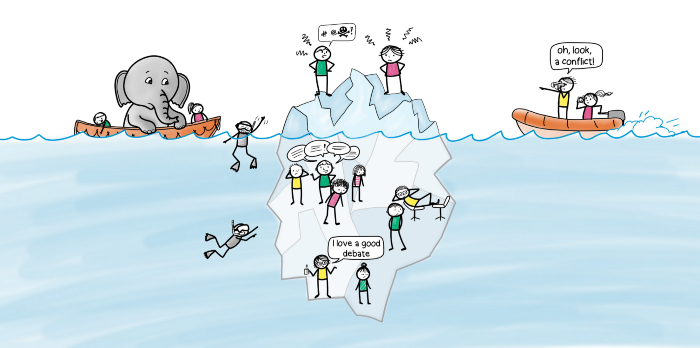

A while ago I was taking a walk with my partner Lisanne. A noisy flock of geese flew overhead in a messy V formation. We laughed at the amount of noise they produced. It all looked very chaotic. Then another flock flew overhead. It was a similar number of birds. But their formation was tight. And there was hardly any communication. Except for a few “gacks”, the flock effortlessly flew into the distance.
This reflects something I’ve also noticed in teams. Some teams are very noisy, whereas others are not. I used to believe that noise was a good sign and I actively tested teams for it. I thought that it showed that people were communicating and coordinating. But the more I’ve worked with teams, and as part of teams, the more I’ve begun to question if this is really such a good sign. It may also reflect something else: a lack of work agreements and shared mental models.
Do you have a team manifest or team contract? Or a list of work agreements on how you will work together as a team? If you don’t have one, or when it's mostly in your head, I would recommend you do so with your team. Work agreements are basically team-agreed expectations on how you will behave, interact and deal with certain scenarios.
Not everybody sees the value of work agreements. Some find the process of creating them “childish” or “a waste of time”. And there is some truth to that. Not all work agreements are useful or helpful.
So how do you make proper work agreements? What should those agreements focus on? And how can you capture them well? I want to use this post to share some of our experiences. I also include insights from scientific research, as existing models about teamwork can provide a lot of focus.
This post is part of our “in-depth” series. Each post discusses scientific research that is relevant to our work with Scrum and Agile teams. We hope to contribute to more evidence-based conversations in our community and a stronger reliance on robust research over personal opinions. Since most of our work is community-funded, these posts are made possible by our patrons. If this content adds value to you, please consider supporting us too. We can use your help.
The primary reason why many organizations work with teams is that they believe that people are more effective together instead of apart. This is particularly true for complex work.
Scientific research provides strong evidence to support this belief. But not all teams are equal. And certainly, not all teams are high-performing. Much of the research that investigates why some betters are more effective than others has focused on implicit coordination (Kleinman & Serfaty, 1989). This is the ability of team members to act in concert without explicit coordination (MacMillan, Entin & Serfaty, 2004). Implicit coordination is a proactive style of communication where members anticipate what others will need from them (Butchibabu et. al., 2016). In fact, a lot of implicit coordination happens without any overt communication at all. This is different from explicit coordination, which is a reactive style that happens in response to requests or commands (ibid). You can notice explicit coordination through questions like “What should I do?” and “How can I help?”, or requests like “Can you do this”.

In fact, when researchers compare high-performing teams with low-performing teams, they consistently find that high-performing teams communicate less. This effect has been observed with flight crews (Orasuna, 1990), nuclear plant control crews (Waller, Gupta & Giambatista, 2004), and work teams (Urban et. al., 1995). This is not because team members have developed telepathy, but because they have learned so well what is expected of each other that they don’t need to communicate about that anymore. So this keeps a lot of their bandwidth open for problem-solving, critical communication, and maintaining focus.
Scientists call this shared understanding team cognition. It has been linked to higher performance and motivation (Mathieu et al, 2000), increased effectiveness (Kearny, Gebert & Voelpel, 2009), and generally explains a substantial amount of the variance (~19%) in the effectiveness of teams (De Church & Mesmer-Magnus, 2010). You can read more about this here.
You can observe implicit coordination in Scrum teams when you look at how work moves across a Scrum board, or on- and of the Sprint Backlog. You can also see it at work when one developer offers to pair up with another developer because the task is difficult. Or when a Product Owner already prepares test cases for a complex item. Or when a team member starts testing a deployment as another developer runs it. The more that happens, the more effective your team probably is.
“High-performing teams are much better at coordinating their work than members of other teams.”
This research helps us understand why work agreements are helpful. Teams tend to develop stronger team cognition when they work together for a longer period of time (De Church & Mesmer-Magnus, 2010). This makes sense; the more you work with the same people, the more likely you are to anticipate their needs and yours. Work agreements, a team manifesto, or a team contract can help you fast-track some of that understanding by talking openly and specifically about how you will work together.
This is also why the Scrum framework includes the Definition of Done. It is basically a subset of work agreements that specifically answer the question: “How will our team ensure that we deliver high-quality increments to our stakeholders every Sprint?”. Once that definition is clearly engrained in the minds of its members, there is less need to constantly talk about it, decide about it, and coordinate work to assure it.
What should work agreements address?
So while work agreements are useful to create high-performing teams, not all agreements are useful. Which areas of coordination are most important? Fortunately, we can also learn from scientific research here:
The first area to focus on in your work agreements is how to coordinate the work as it flows from member to member. Butchibabu and her colleagues (2016) performed an experiment with 13 teams. They found the strongest effect on performance when team members announce their next goal, like “I just completed [item] and will now start work on [item]”. This is a great opportunity for others to synchronize their work. This communication doesn’t need to be verbal. It may suffice to move an item on the Scrum Board or Kanban Board to “Done” or “Ready for Review”, although a verbal statement is probably clearer for teams where the Scrum Board isn’t visible all the time. We wrote more about this kind of stigmergic action in this post.
We’ve always found the following sentences useful to complete for work agreements in this area:

Another important area is how to coordinate the use of skills. This ties closely into research on team cognition and cross-functionality. DeChurch & Mesmer-Magnus (2010) combined the results from 58 scientific studies and found that teams benefit greatly from knowing the skills of each of their members and knowing how to effectively combine those skills for the tasks at hand. This was far more important than distributing those skills evenly among members.
We’ve found that the creation of a skill matrix is a good starting point to identify potential work agreements in this area. Once you have a skill matrix, every member can talk about what they normally need from other team members to perform a skill effectively. For example, a developer may want to spend some time with their designer before they start implementation on UI-oriented items. Or a tester may prefer to pair up with a developer when testing items. Note that we’re using functional job titles here for clarity; not all companies use them, and the Scrum Guide only talks about “developers”.

The process of creating a skill matrix and having an open and honest conversation about the skills and what each of the member's needs from others are probably more important than the work agreements that come out of it. So we wouldn’t recommend capturing member-specific work agreements (e.g. “Tim [developer] needs design from Jill [designer]”). Instead, it may be useful to identify more high-level work agreements that concern the use of skills:
Another important area is how to coordinate the navigation of conflict. We know from research in teams that even light conflict has a negative effect on team productivity (De Dreu & Weingart, 2003). Each person has their own style of responding to conflict. Some avoid it, some always yield, some force their will, and others seek compromise or a solution where everyone wins (Pruitt & Rubin, 1986). Teams benefit from knowing their different styles, as well as how to understand and navigate team-level conflict. For example, what may feel like a lively debate for one member can be an anxiety-inducing argument for another.

We’ve always found the following sentences useful to complete for work agreements in this area:
Another important area is how to coordinate psychological safety. Psychological safety is “a shared belief held by members of a team that the team is safe for interpersonal risk-taking” (Edmondson, 1999). Many studies have found that psychological safety has a positive influence on team effectiveness (Edmondson, 2014). This includes our own research with data from 2.000 Scrum teams (Verwijs & Russo, under peer review). Members can create a climate of psychological safety by listening to other viewpoints, encouraging feedback, and admitting mistakes. Much of this behavior can be discussed and captured in work agreements.
We’ve always found the following sentences useful to complete for work agreements in this area:
Finally, it is important to talk with your team about how to coordinate work pressure, stress, and the negative consequences of it. Many studies have shown that stressed developers make more mistakes (Furuyama, Arai & Lio, 1996, Sonnentag et. al., 1994). High-stress environments are also more likely to burn members out (Sonnentag et. al., 1994).
We’ve always found the following sentences useful to complete for work agreements in this area:
We wrote a lot more about stress and sustainable pace in this post, as well as examples of work agreements.
The five areas we presented here are not meant to be exhaustive. But these are prevalent in research around team effectiveness. So they’re a good start if you’re looking for evidence-based recommendations on what to include.
You can also include areas such as learning and improvement, diversity and inclusiveness, and personal growth. But here too, it is probably better to start with a minimal set of work agreements that you evolve as a team over time than an exhaustive list that nobody remembers.
There are many ways to capture work agreements. The go-to solution for most teams is to put them on a flip and put that in the team room. Or a virtual alternative in Mural. These are fine strategies.
However, the most important place to capture work agreements is in the brains of team members. A poster with wonderful work agreements has no value when members weren’t involved, when they didn’t discuss them and when they don’t refer to it. We’ve seen many examples where teams spent a morning to create a team contract, and then never looked at it again. It makes sense that people start seeing that as a waste of time.
The best way to make work agreements come alive, and for people to better remember them, is to use engaging ways to create them. Liberating Structures are a great fit here, as they purposefully give a voice to every member. You can first share experiences with work agreements and high-performing teams in a 1–2–4-ALL. Then use 25/10 Crowd Sourcing to first identify a broad set of work agreements, and then use Min Specs to narrow it down to the essential agreements. We’ve also had great experiences with the creation of “team posters” that included work agreements, the team name, and other characteristics (like a Mascotte). The shared activity of creating this poster is fun and something memorable. And you can leave the poster in the team room.

So how does all this work for fluid teams? Or teams that are otherwise subjected to frequent changes in their composition? In those situations where team members frequently have to work with new members, it is not surprising that much more effort will need to be made to continuously develop, refresh and refine work agreements and shared mental models. In fact, Bushe & Chu (2011) reviewed research on fluid teams and concluded that, for this reason, fluid teams may never have the same potential for high performance as more stable teams. Thus, the evidence and the theoretical models we have to understand why some teams perform better than others strongly prefer team stability over team fluidity. I wrote much more extensively about the science around team stability and fluidity here for the interested reader.
We used this post to dive deep into work agreements, and how they can drive teams to become high-performing. Through scientific research, we know that teams that become high-performing have developed a strong understanding of what each member of the team needs. That allows members to anticipate and prepare the right information ahead of time, rather than having to explicitly coordinate it. This kind of implicit coordination is one factor that distinguishes high- from low-performing teams. You can fast-track this process with good work agreements.
We also covered five areas that you should probably make work agreements about. Each of these areas contributes to team effectiveness:
With the proper work agreements, your team is almost certainly better able to act in concert, much like the geese in the introduction. Good luck!
Butchibabu, A., Sparano-Huiban, C., Sonenberg, L., & Shah, J. (2016). Implicit coordination strategies for effective team communication. Human factors, 58(4), 595–610.
Bushe, G. R., & Chu, A. (2011). Fluid teams: solutions to the problems of unstable team membership. Organizational Dynamics, 40(3), 181–188.
DeChurch, L. A., & Mesmer-Magnus, J. R. (2010). The cognitive underpinnings of effective teamwork: a meta-analysis. Journal of applied psychology, 95(1), 32.
Edmondson, A. C., & Lei, Z. (2014). Psychological safety: The history, renaissance, and future of an interpersonal construct. Annu. Rev. Organ. Psychol. Organ. Behav., 1(1), 23–43.
Edmondson, A. (1999). Psychological safety and learning behavior in work teams. Administrative science quarterly, 44(2), 350–383.
Furuyama, T., Arai, Y., & Iio, K. (1996). Analysis of fault generation caused by stress during software development. In Achieving Quality in Software (pp. 14–28). Springer, Boston, MA.
Kearney, E., Gebert, D., & Voelpel, S. C. (2009). When and how diversity benefits teams: The importance of team members’ need for cognition. Academy of Management journal, 52(3), 581–598.
MacMillan, J., Entin, E. E., & Serfaty, D. (2004). Communication overhead: The hidden cost of team cognition.
Orasanu, J. (1990). Shared mental models and crew decision-making. Princeton, NJ.
Kleinman, D. L., & Serfaty, D. (1989, April). Team performance assessment in distributed decision making. In Proceedings of the symposium on interactive networked simulation for training (pp. 22–27). Orlando, FL: University of Central Florida.
Sonnentag, S., Brodbeck, F. C., Heinbokel, T., & Stolte, W. (1994). Stressor‐burnout relationship in software development teams. Journal of occupational and organizational psychology, 67(4), 327–341.
Verwijs, C., & Russo, D. (2021). A Theory of Scrum Team Effectiveness. arXiv preprint arXiv:2105.12439.
Waller, M. J., Gupta, N., & Giambatista, R. C. (2004). Effects of adaptive behaviors and shared mental models on control crew performance. Management Science, 50(11), 1534–1544.